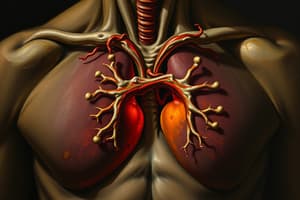Podcast
Questions and Answers
Where are epinephrine and norepinephrine formed?
Where are epinephrine and norepinephrine formed?
- Thyroid gland
- Adrenal cortex
- Pituitary gland
- Adrenal medulla (correct)
What is the mechanism of catecholamine release from adrenal medullary cells?
What is the mechanism of catecholamine release from adrenal medullary cells?
- Diffusion
- Exocytosis (correct)
- Endocytosis
- Osmosis
What is the range of hormone concentrations in the circulating blood?
What is the range of hormone concentrations in the circulating blood?
- 1 microgram to 1 milligram
- 1 picogram to a few micrograms (correct)
- 1 nanogram to 1 microgram
- 1 milligram to 1 gram
What type of feedback control prevents over-secretion of hormones?
What type of feedback control prevents over-secretion of hormones?
What is an example of a hormone that exhibits cyclical variations in release?
What is an example of a hormone that exhibits cyclical variations in release?
What determines the duration of action of hormones?
What determines the duration of action of hormones?
Flashcards are hidden until you start studying
Study Notes
Synthesis and Secretion of Amine Hormones
- Epinephrine and norepinephrine are synthesized in the adrenal medulla and stored in preformed vesicles until secreted.
- These catecholamines are released from adrenal medullary cells by exocytosis.
Characteristics of Hormone Functions
- Hormones have their own characteristic onset and duration of action, e.g., epinephrine and norepinephrine have rapid onset and duration, while thyroxine may take months to have full effect.
- The concentrations of hormones in the circulating blood and hormonal secretion rates are small (range from 1 picogram to a few micrograms).
- Hormonal secretion is controlled by feedback mechanisms, including:
- Negative feedback: The hormone or its product has a negative effect to prevent over-secretion or over-activity.
- Positive feedback: The biological action of the hormone causes additional secretion of the hormone, leading to a surge.
- Cyclical variations in hormone release: Periodic variations in hormone release influenced by development, aging, diurnal cycle, and sleep (e.g., growth hormone and cortisol).
Transport of Hormones in the Blood
- Water-soluble hormones are dissolved in plasma and diffuse into interstitial spaces to target cells.
- Lipid-soluble hormones (steroid and thyroid hormones):
- Circulate in the blood bound to plasma proteins.
- Must dissociate from the carrier and diffuse across capillaries to access target cells.
- Can act as hormone reservoirs.
- Binding of hormone to plasma proteins slows their clearance from the plasma.
Studying That Suits You
Use AI to generate personalized quizzes and flashcards to suit your learning preferences.




